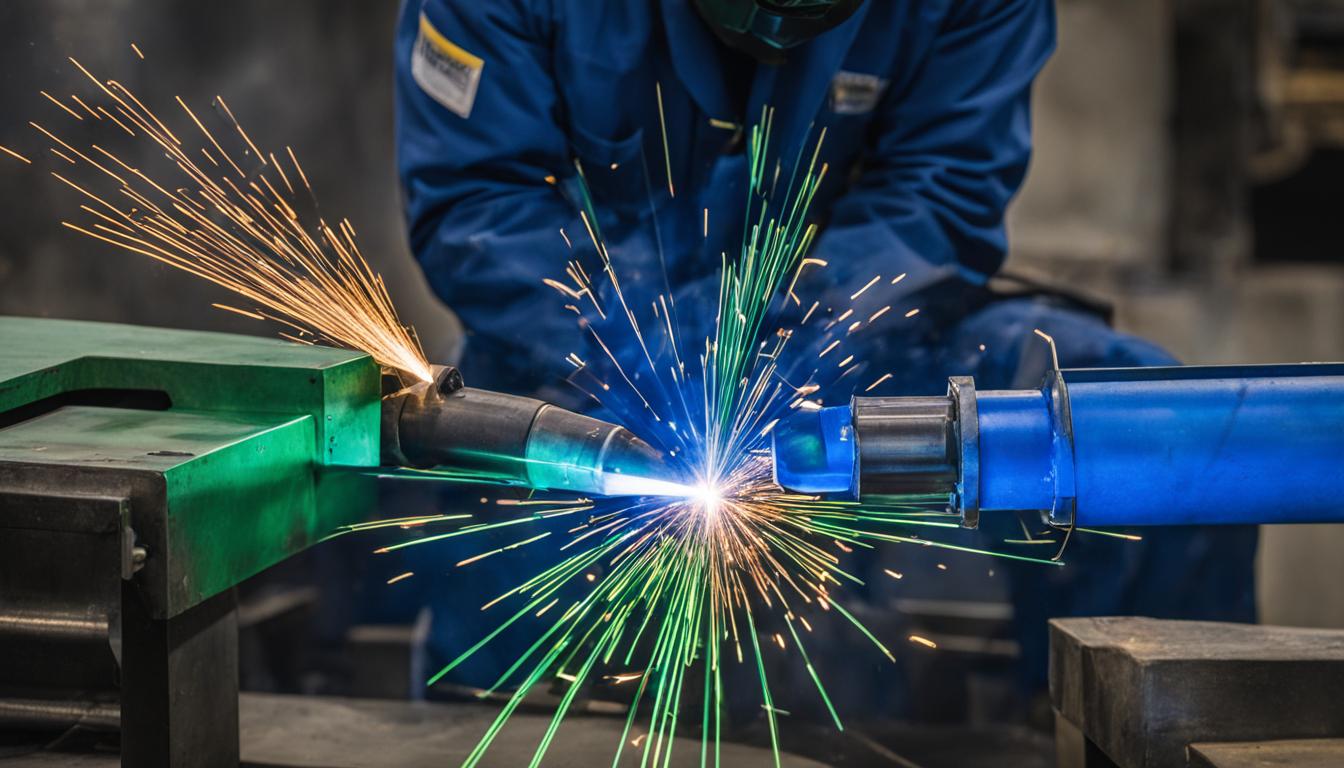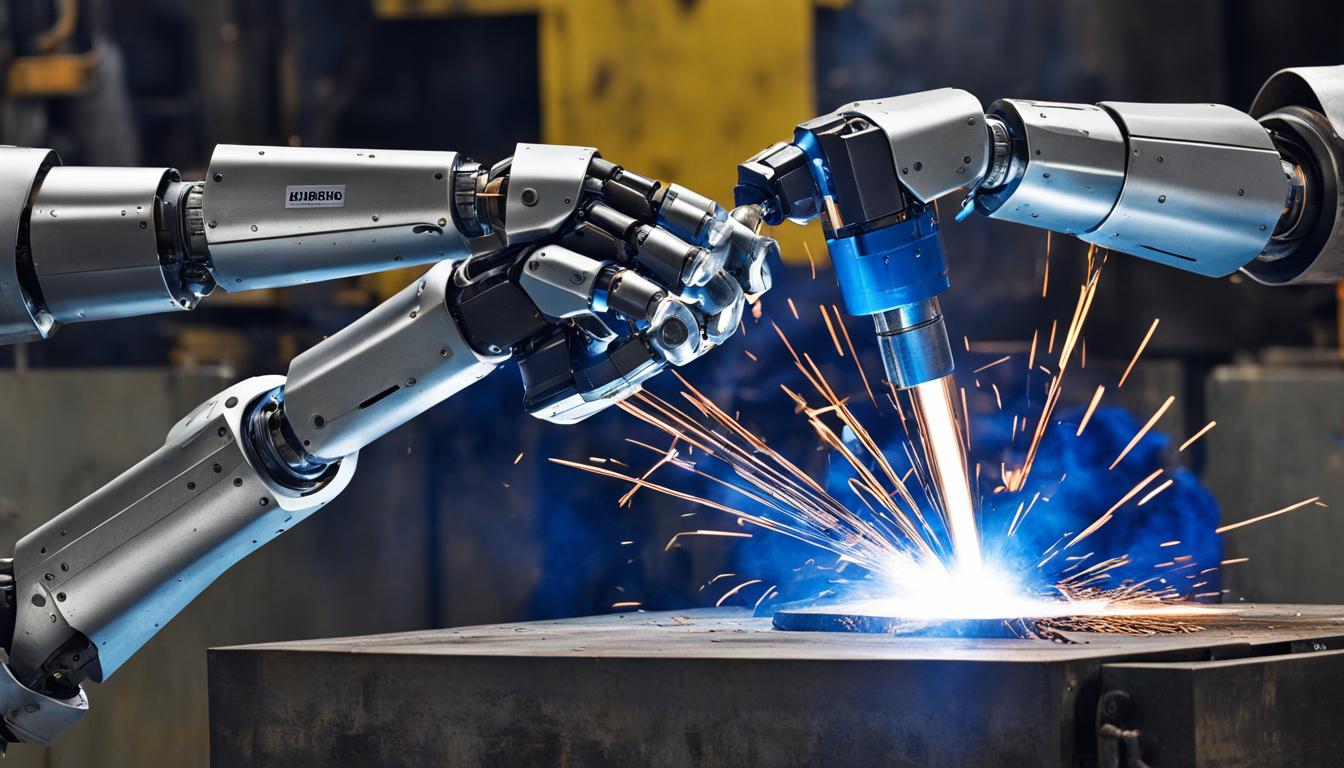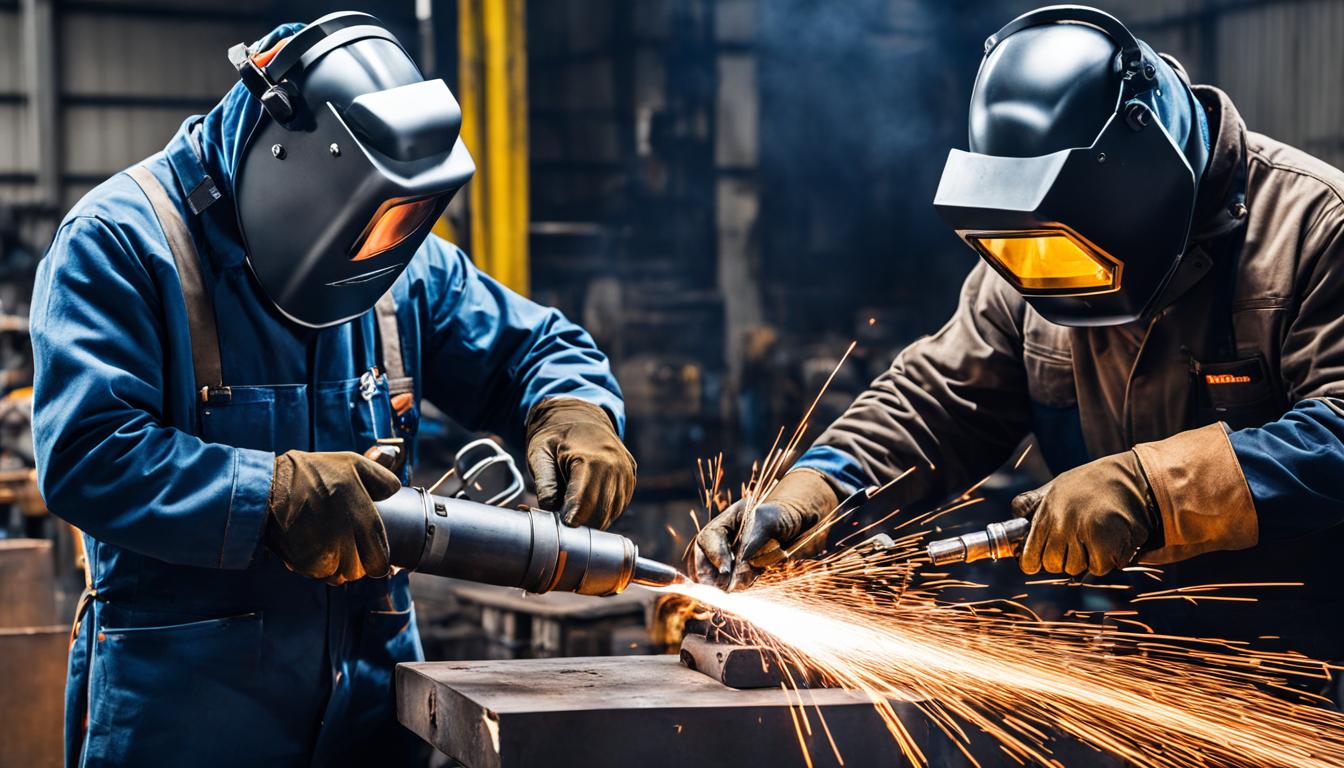What is the difference between MIG welding and MAG welding? If you’re familiar with welding processes, you may have come across these terms. MIG (metal inert gas welding) and MAG (metal active gas welding) both fall under the category of gas metal arc welding (GMAW), but they have distinct characteristics and applications.
In MIG welding, inert gases like argon and helium are used as shielding gases to protect the weld puddle from atmospheric contamination. On the other hand, MAG welding uses active gases like carbon dioxide and oxygen for shielding. This difference in shielding gases leads to variations in the welding process, weld characteristics, and advantages for each method.
Understanding the differences between MIG and MAG welding is crucial for selecting the appropriate process for your welding needs. In the upcoming sections, we will delve deeper into the working principles, advantages, disadvantages, and the metal transfer modes in MIG and MAG welding. By the end, you’ll have a comprehensive understanding of these welding processes and be able to make informed decisions regarding which method to choose for your specific welding projects.
Understanding GMAW and Its Working Principle
Gas metal arc welding (GMAW) is a versatile welding process that includes both MIG (metal inert gas) and MAG (metal active gas) welding techniques. GMAW utilizes a consumable electrode, in the form of a solid wire, which is fed through a wire feeder. This wire acts as the welding material and is energized by a power source.
The GMAW process relies on the use of a shielding gas to protect the weld puddle from atmospheric contamination. This shielding gas, which is either inert (in the case of MIG welding) or active (in the case of MAG welding), creates an environment that prevents oxidation and ensures the integrity of the weld.
The MIG welding machine combines the wire feeder and power source into a single unit, making it convenient and efficient to use. The power source provides the necessary electrical energy for the welding process, while the wire feeder controls the speed and feed of the solid wire.
During GMAW, the welding machine generates short-circuiting electricity, causing the wire to melt and deposit metal droplets into the joint. This continuous process creates the characteristic sizzling sound and spatter commonly associated with GMAW.
Exploring MIG Welding Process
MIG welding, or metal inert gas welding, is a widely-used welding process that utilizes inert gases like argon and helium as the shielding gas. These gases ensure that the weld area remains unaffected by atmospheric contamination, preventing any impurities from compromising the quality of the weld. MIG welding is particularly effective for welding non-ferrous materials such as aluminum, magnesium, copper, and nickel.
For MIG welding of non-ferrous metals, argon gas is the preferred choice as it provides excellent arc stability and helps create clean, visually appealing welds. In certain cases, helium can be added to the shielding gas mixture to increase the heat of the arc and improve penetration.
One of the key advantages of MIG welding is the ease with which the weld puddle can be ionized, allowing for a stable arc with lower voltage requirements. This stability results in better control over the welding process and ensures consistent weld quality. Furthermore, MIG welding produces aesthetically pleasing welds due to the absence of oxidation and the clean nature of the weld pool shielded by the inert gases.

| Advantages of MIG Welding |
|---|
| Easy ionization of the weld puddle |
| Long arc stability with lower voltage |
| Creates clean and visually appealing welds |
Understanding MAG Welding Process
MAG welding, or metal active gas welding, is a widely used welding process that utilizes active gases or a combination of active and inert gases as the shielding gas. The choice of shielding gas directly influences various aspects of the welding process, including weld penetration, puddle fluidity, arc stability, spatter, and the characteristics of the weld bead.
One of the common gases used in MAG welding is carbon dioxide (CO2). Carbon dioxide, either as an active gas or in a mixture with argon, is known for its ability to create a stable arc and achieve deep weld penetration. This makes MAG welding particularly suitable for welding steel, a widely used ferrous metal.
MAG welding offers several advantages, making it a popular choice in various industries. Firstly, the use of active gases, such as carbon dioxide, provides a cost-effective solution compared to the use of purely inert gases. Active gases are more readily available and can be sourced at a lower cost, contributing to the overall cost-effectiveness of the welding process.
The increased weld penetration achieved through MAG welding allows for stronger and more robust welds, particularly when working with thicker materials. The high heat generation during MAG welding also ensures efficient fusion between the base metal and the filler material.
Furthermore, MAG welding’s ability to weld ferrous metals like steel opens up a wide range of applications in various industries, such as automotive, construction, and manufacturing.
In summary, MAG welding, with its utilization of active gases like carbon dioxide, offers distinct advantages in terms of cost-effectiveness, increased weld penetration, high heat generation, and the ability to weld ferrous metals like steel. These characteristics make MAG welding a versatile and reliable option for welding applications where deep penetration and strong welds are required.
| Advantages of MAG Welding |
|---|
| Cost-effectiveness due to lower cost and availability of active gases |
| Increased weld penetration for stronger welds |
| High heat generation for efficient fusion |
| Ability to weld ferrous metals like steel |
Metal Transfer Modes in MIG/MAG Welding
MIG and MAG welding processes utilize different metal transfer modes, each with its unique characteristics and applications.
Short-Circuiting Transfer
In short-circuiting or dip transfer, the molten metal at the wire’s tip is transferred to the weld pool by momentarily dipping the wire into the pool. This process is commonly used in operations that require low heat input. Skilled welding techniques are necessary to prevent lack of fusion and ensure proper bonding.
Globular Transfer
Globular transfer occurs when the welding current is insufficient, leading to the formation of large droplets of weld metal at the wire’s tip. This mode of transfer is not commonly preferred due to its inconsistent results and increased spatter production.
Spray Transfer
Spray transfer involves using comparatively higher voltage and current to produce a fine spray of small droplets of molten metal. This transfer mode is primarily used for high heat input applications and offers excellent weld quality and high deposition rates. The resulting welds are characterized by their smooth appearance and minimal spatter production.
Pulsed Transfer
Pulsed transfer combines the advantages of spray transfer with reduced heat input. It involves applying pulses of high welding current to detach small droplets of molten metal. This mode is frequently used when precise control over the weld pool is required, allowing for better heat management and improved welding characteristics.

Advantages of MIG/MAG Welding
MIG (Metal Inert Gas) and MAG (Metal Active Gas) welding processes offer numerous advantages, making them widely adopted in various applications.
Fast Production of High-Quality Welds: One of the main advantages of MIG/MAG welding is the ability to produce welds quickly without sacrificing quality. These processes can be operated in several ways, including semi and fully automatic, even with robotic systems. This allows for efficient and high-speed production, making MIG/MAG welding suitable for large-scale projects.
Versatile Welding Process: MIG/MAG welding is a versatile process that can be used to weld a wide range of materials, including both ferrous and non-ferrous metals. MIG welding is particularly well-suited for welding non-ferrous metals like aluminum, while MAG welding excels in welding ferrous metals like steel. This versatility makes MIG/MAG welding a preferred choice in many industries.
Comparison Table: Advantages of MIG Welding vs. MAG Welding
| Advantages | MIG Welding | MAG Welding |
|---|---|---|
| Protection from Chemical Reactions | ✓ | |
| Increased Weld Penetration | ✓ | |
| High Heat Generation | ✓ | |
| Suitable for Non-Ferrous Metals | ✓ | |
| Suitable for Ferrous Metals | ✓ |
The comparison table above highlights the specific advantages of MIG welding and MAG welding. MIG welding offers protection from chemical reactions, resulting in clean and clear welds free from oxidation, which is particularly useful when working with non-ferrous materials. On the other hand, MAG welding provides increased weld penetration, high heat generation, and the ability to weld ferrous metals.
In addition, both MIG and MAG welding processes can be easily integrated into automated welding systems, further enhancing productivity and consistency in weld quality.
Overall, the advantages of MIG/MAG welding make these processes a preferred choice in many industries, enabling fast production of high-quality welds and offering versatility in welding different materials.
Disadvantages of MIG/MAG Welding
While MIG and MAG welding processes offer numerous advantages, they also have certain disadvantages that should be considered. These disadvantages include:
- Limitations for vertical or overhead welding: MIG welding may not be the most suitable choice for vertical or overhead welding applications due to the requirement of the short-circuiting transfer mode. Without the presence of flux, there is no support for the fluid weld pool in these positions, making it challenging to achieve desired results.
- Outdoor welding limitations: Welding using MIG or MAG processes cannot be performed outdoors without proper enclosures. The shielding gas used in these processes, such as argon or carbon dioxide, needs protection from wind interference. Without appropriate shielding, the quality of the weld can be compromised, leading to potential defects.
- Limited deoxidants: MIG and MAG welding processes have limited deoxidants, which necessitates thorough removal of rust, scale, and other contaminants from the workpiece before welding commences. Any residual oxidation or impurities can negatively impact the quality and strength of the weld joint.
For outdoor applications or positional welding where these limitations may pose challenges, an alternative welding method like flux-cored arc welding (FCAW) with MAG may be more suitable. FCAW uses a flux-cored wire that provides both shielding and deoxidizing properties, making it more versatile for different welding scenarios.
It is important to consider these disadvantages alongside the advantages when deciding on the appropriate welding process for a specific application. Each welding method has its strengths and weaknesses, and selecting the right process will depend on factors such as the type of metal being welded, the desired weld characteristics, and the environmental conditions.
Selecting between MIG and MAG Welding
When choosing between MIG welding and MAG welding, it’s important to consider the material you are welding and the desired outcome. MIG welding is the preferred choice for welding aluminum due to its ability to provide a stable arc and protection from oxidation. On the other hand, MAG welding, with its use of active gases, is better suited for welding steel as it generates higher heat and ensures deeper penetration.
The availability and cost of shielding gases also play a significant role in the selection process. While MIG welding uses inert gases like argon and helium, MAG welding utilizes active gases such as carbon dioxide and oxygen. It’s essential to consider both the suitability of the gases for your specific application and their accessibility.
Both MIG and MAG welding processes can be seamlessly integrated into robotic welding systems, offering versatility in joining different metals and alloys. Whether you’re working with aluminum or steel, understanding the distinctions between MIG and MAG welding will help you make an informed decision and achieve optimal results.
Expertise in MIG/MAG Welding
When it comes to MIG/MAG welding, having the right expertise is crucial for achieving optimal results. That’s where TWI (The Welding Institute) comes in. With their extensive knowledge and experience, TWI specializes in the development and qualification of MIG/MAG welding procedures for various industries.
At TWI, our team of experts is well-versed in optimizing welding parameters, selecting the appropriate shielding gases, and ensuring weld quality and efficiency. We understand the unique challenges that arise in welding projects and offer customized solutions tailored to your specific needs.
Whether it’s a complex welding project or industry-specific requirements, seeking professional welding services with MIG/MAG expertise can make all the difference. TWI’s team of professionals is equipped with the skills and knowledge to handle even the most demanding welding tasks, delivering high-quality welds and ensuring project success.
With our MIG welding expertise, you can expect precise and clean welds on non-ferrous metals like aluminum, magnesium, copper, and nickel. Our MAG welding expertise, on the other hand, allows us to tackle ferrous metals like steel with increased weld penetration and high heat generation.
When it comes to professional welding services, TWI is your trusted partner. Our commitment to excellence and dedication to staying at the forefront of welding technology makes us the go-to choice for all your MIG/MAG welding needs.
| Benefits of TWI’s MIG/MAG Welding Expertise |
|---|
| Optimized welding parameters |
| Selection of appropriate shielding gases |
| Enhanced weld quality and efficiency |
| Expertise in welding non-ferrous and ferrous metals |
| Customized solutions for complex projects |
| State-of-the-art welding technology |
Current Practices and Industry Norms
While MIG and MAG welding are technically distinct processes, it is common for the industry to use the term “MIG welding” to refer to all gas metal arc welding. This is due to the widespread familiarity with the term and the understanding among professionals of which shielding gas to use for each metal.
Professionals are aware that MAG welding with active gases is suitable for welding steel, while MIG welding with inert gases is preferred for non-ferrous metals. Although this industry norm may seem confusing to outsiders, professionals adhere to the appropriate shielding gas guidelines for each specific application.
When it comes to current practices in MIG welding, professionals prioritize using the recommended inert gases such as argon and helium to ensure clean and contamination-free welds. They also follow established welding techniques and parameters to achieve optimal results.
In the case of MAG welding, professionals rely on active gases like carbon dioxide and oxygen to enhance weld penetration and overall quality. They fine-tune welding parameters such as voltage and wire feed speed to achieve the desired results.
It is important to note that industry norms and current practices are continuously evolving as new technologies, materials, and techniques emerge. Professionals stay up to date with the latest advancements and adapt their practices accordingly to ensure efficient and high-quality welding processes.
| MIG Welding | MAG Welding |
|---|---|
| Uses inert gases like argon and helium as shielding gas | Utilizes active gases like carbon dioxide and oxygen as shielding gas |
| Preferred for non-ferrous metals | Suitable for welding steel |
| Provides protection from chemical reactions | Offers increased weld penetration |
| Produces clean and visually appealing welds | Enables high heat generation |
| Ideal for applications requiring low spatter | Cost-effective and readily available active gases |
Conclusion
In conclusion, MIG and MAG welding are two popular processes in the world of gas metal arc welding (GMAW). The key difference between the two lies in the type of shielding gas used. MIG welding relies on inert gases like argon and helium to protect the weld puddle, making it suitable for non-ferrous metals. On the other hand, MAG welding utilizes active gases such as carbon dioxide and oxygen, making it ideal for welding steel.
Both MIG and MAG welding have their own advantages and disadvantages. MIG welding offers easy ionization of the weld puddle, long arc stability, and visually appealing welds. MAG welding, on the other hand, provides increased weld penetration, high heat generation, and the ability to weld ferrous metals like steel.
When selecting between MIG and MAG welding, it is important to consider the specific requirements of the welding task. Both processes offer fast production of high-quality welds, and they can be automated using robotic systems. By understanding the differences and carefully choosing the appropriate process, welders can achieve optimal results in various welding applications.
